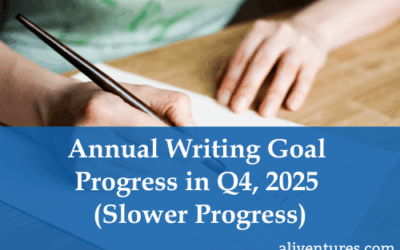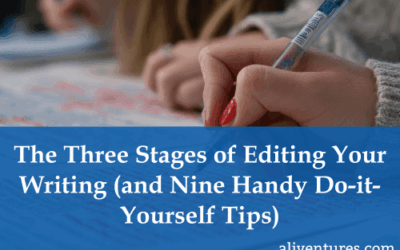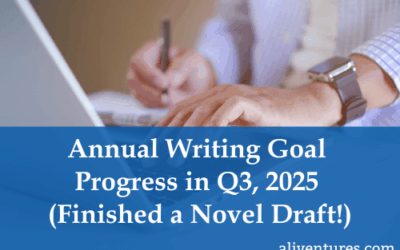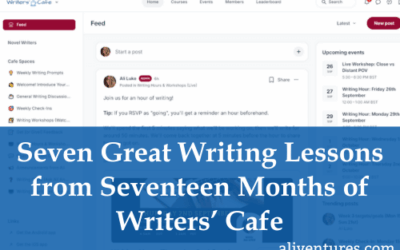Welcome to the Aliventures blog!
Want to write better, finish what you start, or tackle that novel you’ve been dreaming about? You’re in the right place! Choose an options below, scroll down for recent posts, or take a look at the Start Here page.
Annual Writing Goal Progress in Q4, 2025 (Slower Progress)
We’re getting close to the end of 2025. In fact, 12th December always feels a little bit like the ending of a year for me … because it’s my birthday! So how did things go in Q4, and during 2025 as a whole? Recap: My Writing Goals for 2025 Way back in January, I wrote...
The Three Stages of Editing Your Writing (and Nine Handy Do-it-Yourself Tips)
Whether you love editing or hate it, if you’re a writer, there’s no way to avoid it. You may well have support – from beta readers, your spouse, your writing group or a professional editor – but a fair amount of editing needs to take place as part of your own writing process…
Interiority: Six Different Ways to Show Your Character’s Thoughts on the Page [With Examples]
One brilliant thing about the novel (and short story) as a form of storytelling is that it gives a unique access inside characters’ minds. If you’re writing a script for a play or for film…
How to Start a Novel: Eight Options, Plus Examples
Writing the first scene of a novel is tricky. Perhaps you’ve been slowly developing an idea for weeks, months, or even years. You might have written pages of notes or created a full outline. And now you’ve opened up the document to start … but how do you actually...
About
I’m Ali Luke, and I live in Leeds in the UK with my husband and two children. Aliventures is where I help you get your novel all the way to “the end”.
Archives
Just head on over to the Archive:
Writing Action Scenes That Grip Readers: Five Practical Tips, Plus Examples
Are you struggling to write action scenes? A lot of writers find it tricky to craft a scene that involves a lot of action. These might be crucial scenes in your plot – perhaps the turning point in the middle of your story, or the climax at the end – and you want them...
Annual Writing Goal Progress in Q3, 2025 (Finished a Novel Draft!)
We’ve got just under three months left of 2025 … how’s your writing going? If it’s going well, hurrah! Keep it up! If you’re struggling with lost momentum (or lost motivation), then check out my Finish Your Novel group. I’m about to open registration next week, on...
Do You Head-Hop? Getting Third Person Point of View Right
When you’re writing in the third person, it’s easy to end up head-hopping. This is when you move from one person’s perspective to another, without quite meaning to. It’s not a deliberate perspective shift, at the end of a scene or at some natural break. Instead, it’s like the point of…
Annual Writing Goal Progress in Q3, 2025 (Finished a Novel Draft!)
We’ve got just under three months left of 2025 … how’s your writing going? If it’s going well, hurrah! Keep it up! If you’re struggling with lost momentum (or lost motivation), then check out my Finish Your Novel group. I’m about to open registration next week, on...
Do You Head-Hop? Getting Third Person Point of View Right
When you’re writing in the third person, it’s easy to end up head-hopping. This is when you move from one person’s perspective to another, without quite meaning to. It’s not a deliberate perspective shift, at the end of a scene or at some natural break. Instead, it’s like the point of…
Seven Great Writing Lessons from Seventeen Months of Writers’ Cafe
I launched Writers’ Cafe in May 2024 … and it’s been fantastic to see lots of different writers come through the doors! Through our weekly check-ins and writing hours, it’s been great to get insights into how different writers are tackling a huge range of projects. I...



![Interiority: Six Different Ways to Show Your Character’s Thoughts on the Page [With Examples]](https://www.aliventures.com/wp-content/uploads/2025/11/interiority-character-thoughts-49297_400x250.png)




